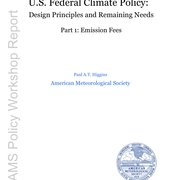Download Report
Executive Summary:
Reducing greenhouse gas emissions almost certainly requires adding a price to those activities that cause emissions. In the broadest sense, policy makers have two cost-effective options for adding a price to climate pollution: 1) restrict the quantity of emissions through a cap-and- trade system, or 2) impose a fee on emissions.
Each approach has strengths and weaknesses and both approaches receive considerable attention from the research community. Policy makers, in contrast, have paid very little attention to emission fees and therefore may be overlooking an important risk management option for dealing with climate change. Here we identify the advantages and disadvantages of emission fees, potentially important design principles for U.S. Federal climate policy, and remaining policy needs that, if met, could help society use the approach to reduce the risks of climate change.
Key Advantages
Fees create a clear price signal to discourage emissions. Emitters know how much their activities will cost and can invest in strategies that reduce those costs (and their emissions). Fees also clarify who gains and who loses from climate policy. This helps with efforts to compensate those hardest hit by policy changes. Implementing a fee is also straightforward for regulators, discourages rent-seeking (i.e., the search for free handouts) by emitters, and avoids the potential for businesses and individuals to manipulate the market.
A clear price signal facilitates international negotiations by revealing the strength of each nation’s efforts at mitigation. Fees also avoid unintended wealth transfers among nations when implemented internationally. Finally, a fee approach maximizes climate protection when rapid technological development enables easier than expected emissions reductions.
Disadvantages
Fees alone cannot ensure an upper limit on emissions the way quantity constraints can. This potential weakness is exacerbated by the fact that multiple market-failures contribute to greenhouse gas emissions, which could limit the effectiveness of a price signal. Unfavorable political framing (e.g., “It’s a carbon tax”) may hinder emission fee policies from moving forward or ensure that only weak measures gain traction. Emission fees remain at an early stage of policy development so moving forward with the approach may delay critically needed mitigation. If some polluters receive exemptions from the fee, then less mitigation will occur and the risk of harmful climate impacts would increase.
Policy Options and Design Principles
Key policy options include the amount of the fee at the outset, the rate it increases over time, which sources are covered, who pays, and how revenues are used. Additional provisions can encourage international cooperation, allow the use of credits and offsets, or provide “quantity containment” to ensure an upper limit on emissions.
Basic economic understanding suggests that incorporating the cost of climate damage into the price of activities that release greenhouse gases would yield considerable net economic benefits. Nevertheless, raising prices on emissions will likely create political obstacles and legitimate fairness concerns.
The goal of policy design depends on subjective value judgments that may not capture the views of all societal stakeholders. This report emphasizes two potential goals for policy design: 1) to seek to address the political obstacles and fairness issues while striving for favorable societal outcomes (i.e., environmental protection and economic improvement), or 2) to focus on maximizing the advantages and minimizing the disadvantages described above.
Policies that comprehensively cover emitting activities have the best chance to maximize emission reductions and minimize cost. This implies upstream implementation (i.e., collection of fees at the mine, wellhead, or point of entry for imports) and coverage of all economic sectors.
The politics of implementing and maintaining an emission fee will likely improve if the policy can create favorable distributional consequences. For example, the revenues generated from a fee could reduce taxes or fund lump-sum payments to taxpayers. These approaches would largely ease harsh distributional burdens, build public support, and potentially allow larger fee increases.
Even the most aggressive mitigation targets currently feasible may be insufficient to avoid catastrophic climate impacts. Fees offer both upside potential (by encouraging rapid reductions when mitigation is cheap) and downside risk (by failing to ensure an upper limit on emissions). A price-quantity hybrid policy that automatically raises the fee to achieve hard targets would ensure a minimum level of climate protection (quantity containment) while creating the potential for even larger emission reductions if technology breakthroughs occur.
The timescales over which climate impacts and mitigation will happen suggest a need for midcourse policy refinement. Approaches that allow adjustments and that respond to learning will be needed.
Finally, U.S. policies that encourage international cooperation have a better chance to reduce global emissions and ease political constraints within the U.S. Border adjustments to ensure equal treatment of traded goods and conditional actions that account for international efforts could encourage cooperation and address fairness concerns.
Remaining Policy Needs
To move forward, emission fees will need wider consideration among policy makers. In the U.S. this will likely require champions in Congress who build support for them among their colleagues and constituents. More broadly, effective responses to climate change will likely depend on a better framework for translating complex scientific information into policy choices. This will occur with better integration of objective scientific understanding and subjective value judgments about risk management. Even then, the level of an emission fee (and the schedule for fee increases) that would bring maximum societal benefits will remain uncertain. Risk management choices must balance the considerable risks of climate damage with the potential impacts of increasing energy and transportation prices.
Finally, a broad family of policies focused on mitigation, adaptation, and possibly geoengineering will be needed for comprehensive management of climate change risks. Therefore, policy makers must recognize that a fee approach is one of a larger suite of tools for dealing with climate change.
